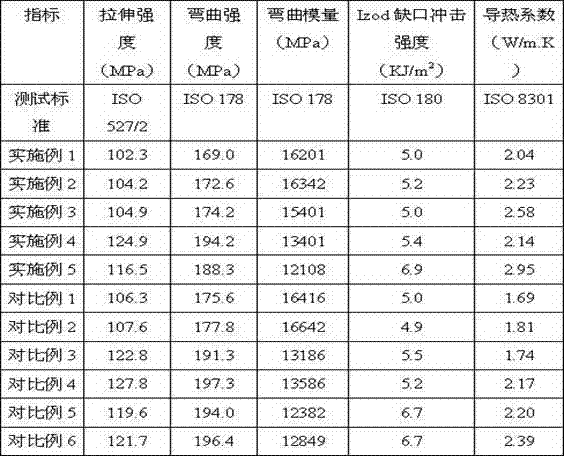Method for improving thermal conductivity of thermal conductive polymer
A heat-conducting polymer and heat-conducting technology, which is applied in the field of functional polymer materials, can solve the problems of material mechanical properties decline, no mention of heat-conducting coefficient heat-conducting plastics, etc., and achieve the effect of improving heat-conducting performance and improving heat-conducting ability
- Summary
- Abstract
- Description
- Claims
- Application Information
AI Technical Summary
Problems solved by technology
Method used
Image
Examples
Embodiment 1
[0029] First, weigh each material according to the following weight percentages: polyphenylene sulfide 23.2wt%, magnesium oxide 65wt%, nano-alumina 0.5wt%, chopped glass fiber 10wt%, silane coupling agent 0.3wt%, montanic acid Wax 0.5wt%, antioxidant 0.5wt%.
[0030] Then add polyphenylene sulfide to the high-speed mixer, add magnesia, montanic acid wax and antioxidant to it, continue to mix evenly, and then feed it to the main feeding port of the twin-screw extruder; add glass fiber to it Into the high-speed mixer, add nano-alumina and silane coupling agent to it, continue to mix evenly, and then feed to the side feeding port of the twin-screw extruder; the raw materials of each component are melted and blended by the twin-screw extruder The granulation was carried out to prepare the thermally conductive polymer.
[0031] The test results of the thermally conductive polymer prepared in this embodiment are shown in Table 1.
Embodiment 2
[0033] First, weigh each material according to the following weight percentages: polyphenylene sulfide 22.7wt%, magnesium oxide 65wt%, nano-alumina 1wt%, chopped glass fiber 10wt%, silane coupling agent 0.3wt%, montanic acid wax 0.5wt%, antioxidant 0.5wt%.
[0034] Then, the thermally conductive polymer was prepared according to the preparation method described in Example 1.
[0035] The test results of the thermally conductive polymer prepared in this embodiment are shown in Table 1.
Embodiment 3
[0037] First, weigh each material according to the following weight percentages: polyphenylene sulfide 21.7wt%, magnesium oxide 65wt%, nano-alumina 2wt%, chopped glass fiber 10wt%, silane coupling agent 0.3wt%, montanic acid wax 0.5wt%, antioxidant 0.5wt%.
[0038] Then, the thermally conductive polymer was prepared according to the preparation method described in Example 1.
[0039] The test results of the thermally conductive polymer prepared in this embodiment are shown in Table 1.
PUM
 Login to View More
Login to View More Abstract
Description
Claims
Application Information
 Login to View More
Login to View More - Generate Ideas
- Intellectual Property
- Life Sciences
- Materials
- Tech Scout
- Unparalleled Data Quality
- Higher Quality Content
- 60% Fewer Hallucinations
Browse by: Latest US Patents, China's latest patents, Technical Efficacy Thesaurus, Application Domain, Technology Topic, Popular Technical Reports.
© 2025 PatSnap. All rights reserved.Legal|Privacy policy|Modern Slavery Act Transparency Statement|Sitemap|About US| Contact US: help@patsnap.com

